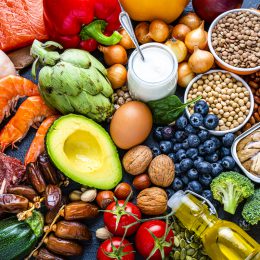The Best and Worst Foods for Managing Arthritis
Diet can play a major role in helping reduce pain and inflammation — or making it worse. Here’s what you need to know.

First, let’s get the bad news out of the way: There’s no cure for arthritis, which is the umbrella term for a group of conditions that cause joint pain, stiffness, and inflammation, including osteoarthritis (the most common type) and rheumatoid arthritis.
The good news? No matter what type of arthritis you have, you can choose from numerous effective treatments to help ease symptoms and maintain quality of life — and many don’t require a prescription. Everyday lifestyle habits such as exercise, weight management, not smoking, and even meditation and massage can all make a difference. Another big boost to arthritis management? What you eat every day.
“Your diet can help you manage arthritis and even improve your symptoms by reducing pain and inflammation and nurturing connective tissue,” says Sydney Lappe, R.D.N., a registered dietitian for Silver Cuisine by bistroMD, a meal delivery service for seniors.
While supplements can help — always check with your doctor before trying them — getting key nutrients from food is often the best first step, Lappe says. That’s because whole foods give you a breadth of vitamins, minerals, fiber, and other components that are great not only for arthritis, but also for overall health. The same can’t be said for a capsule, which helps supplement a balanced diet, rather than replace it.
So what does this mean for your grocery list? Here are some of the best and worst foods and nutrients for managing arthritis.
Best: Foods High in Iron and Copper
These two minerals are essential for everybody but especially for people with osteoarthritis (OA), Lappe says.
To understand why, you first need to know that OA is a degenerative joint disease that happens when cartilage — the flexible connective tissue that acts as a cushion between bones in a joint — breaks down. One of the key components of cartilage is a protein called collagen. That’s where iron and copper come into play.
“Iron helps control the production of collagen in cartilage,” Lappe says. “And copper is absolutely essential for production of connective tissues like cartilage.”
According to the Arthritis Foundation, both minerals also provide a boost to red blood cells, which carry oxygen throughout the body, including to your joints. So there’s more than one reason to add foods rich in iron and copper to your menu.
Some of the best options include:
- Liver, beef, turkey, and fish
- Beans, peas, and lentils
- Spinach and other dark leafy greens
- Whole grains
Worst: Sugary Processed Foods
Enjoying an occasional sweet treat is often fine, particularly if it doesn’t cause a flare-up, but eating sweets too often may worsen arthritis in several ways, Lappe says. Aside from increased inflammation in the body, including your joints, you could gain weight, she says.
Why that’s bad: Extra weight increases the pressure on your joints, especially weight-bearing ones such as the knees, hips, and ankles. It could also have the ripple effect of lowering your activity level, which can make arthritis more problematic.
Does that mean swapping in artificial sweeteners is the solution? Unfortunately, that kind of trade hasn’t been proved to help reduce arthritis symptoms, says Erin Kenney, R.D., author of Rewire Your Gut. Artificial sweeteners may also disrupt the balance of good and bad bacteria in your gut, which can affect certain forms of arthritis such as rheumatoid arthritis, research suggests.
Best: The Right Fats
One of the top ways to reduce inflammation is by eating foods high in omega-3 fatty acids, Kenney says.
“Omega-3s are essential for a healthy inflammatory response in the body, including your joints,” she says. “I recommend consuming two to three servings per week.”
Servings of what exactly? Fatty fish such as salmon, mackerel, sardines, and anchovies are all great options.
Olive oil is another good fat, according to the Arthritis Foundation, because it contains oleocanthal, a compound that has properties similar to nonsteroidal anti-inflammatory drugs (NSAIDs). Oleocanthal works by preventing the production of pro-inflammatory enzymes in the body, the same way ibuprofen works.
In contrast, omega-6 fats from vegetable oils can increase inflammation, Kenney says. These are found in highly processed foods such as cereals, cookies, chips, white bread, and other refined grains.
Subscribe to our newsletter
It's quick and easy. You could be one of the 13 million people who are eligible.
Already a member? Click to discover our 15,000+ participating locations.
Follow Us
Worst: Processed Meats
Meats that have been highly processed — think bacon, hot dogs, and deli meat —have often been associated with negative health outcomes, including heart disease and diabetes. But they can also affect your joints, Kenney says.
“Processed meats have been linked to increased inflammatory markers in the body,” she says. This might be due to high levels of harmful compounds called advanced glycation end products (AGEs). These are formed by cooking animal-derived foods such as meats at high temperatures, and they’re known to cause inflammation.
“That doesn’t mean you can never have bacon again, but it shouldn’t be making a daily appearance on your plate if you’re trying to manage inflammation,” Kenney says. Instead, consider it a special occasion food.
Best: Fruits and Vegetables
No surprise here. No matter what health condition you might have, leaning heavily toward fruits and especially vegetables is a wise choice, Lappe says.
“Fruits and vegetables are rich in antioxidants, the compound that can help protect cells from damage and aging,” she says. “Specific antioxidants, like those found in apples, broccoli, cauliflower, onions, and shallots, might help decrease pain and joint inflammation.”
Here are a few more worthy of a spot on your plate — though any fruits or vegetables are always better than none:
- Garlic
- Ginger
- Spinach
- Berries such as strawberries, blackberries, and blueberries
Check Your SilverSneakers Eligibility Instantly
SilverSneakers members can go to thousands of gyms and fitness locations across the nation, plus take SilverSneakers LIVE online classes that are designed for seniors of all levels. If you have a Medicare plan, it may include SilverSneakers — at no additional cost. Check your eligibility instantly here.
Not eligible for SilverSneakers? You can still get 200+ free SilverSneakers On-Demand videos and stay in touch with us by creating your online account.





